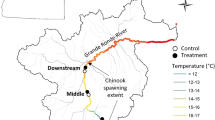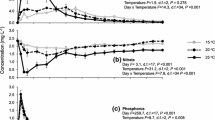Abstract
Decomposition incorporates organic material delivered by Pacific salmon (Oncorhynchus spp.) into aquatic and terrestrial ecosystems of streams where salmon spawn. We hypothesized that salmon tissue decomposition would be faster, and macroinvertebrate abundance and biomass higher, in terrestrial compared to aquatic habitats, and this would be reflected in the nutritional quality of the tissue. Salmon tissue in coarse-mesh bags was placed in four habitats [terrestrial: riparian (RIP), gravel bars (GRA); aquatic: stream sediment surface (STR), buried in sediments (BUR)] in four southeast Alaska watersheds. After 2 (RIP, GRA) or 4 (STR, BUR) weeks of decomposition, tissue dry mass, macronutrient content, and macroinvertebrate colonizer abundance and biomass were determined. Overall, tissue decomposition was rapid (mean k = 0.088 day−1), while nutritional quality remained high based on elemental ratios (mean C:N = 4.9; C:P = 140; N:P = 30), and differed among habitats (Linear-mixed effects model p < 0.05). Macroinvertebrate assemblages colonizing carcasses were unique to each habitat, although Diptera generally dominated. In terrestrial habitats, the dominant macroinvertebrates were Sphaeroceridae (96 % of invertebrate abundance in RIP habitat) and Calliphoridae larvae (98 % in GRA habitat). In aquatic habitats, the dominant macroinvertebrates were Chironomidae (48 % in STR habitat) and Chloroperlidae (72 % in BUR habitat). Macroinvertebrate colonizer abundance and biomass were higher in RIP (mean 286 individuals and 22 mg g−1) than in other habitats (mean 4 individuals and 3 mg g−1) (Friedman p < 0.05). Rapid decomposition rates and high invertebrate biomass, combined with the high nutritional quality of tissue, suggest rapid incorporation of critical salmon nutrients and energy into both aquatic and terrestrial ecosystems.




Similar content being viewed by others
References
American Public Health Association (2005) Standard methods for the examination of water and wastewater, 20th edn. American Public Health Association, Washington DC
Benke AC, Huryn AD, Smock LA, Wallace JB (1999) Length–mass relationships for freshwater macroinvertebrates in North America with particular reference to the southeastern United States. J N Am Benthol Soc 18:308–343
Byrd JH, Castner JL (2010) Forensic entomology: the utility of arthropods in legal investigations, 2nd edn. CRC Press, Boca Raton
Cak AD, Chaloner DT, Lamberti GA (2008) Influence of spawning Pacific salmon on southeastern Alaskan estuaries. Aquat Sci 70:169–178
Campbell EY, Benbow ME, Tiegs SD, Hudson JP, Lamberti GA, Merritt RW (2011) Timber harvest intensifies spawning disturbance of macroinvertebrates in southeastern Alaska streams. J N Am Benthol Soc 30:49–59
Campobasso CP, Di Vella G, Introna F (2001) Factors affecting decomposition and Diptera colonization. Forensic Sci Int 120:18–27
Chaloner DT, Wipfli MS, Caouette JP (2002) Mass loss and macroinvertebrate colonization of Pacific salmon carcasses in south-eastern Alaska streams. Freshw Biol 47:263–273
Christie KS, Hocking MD, Reimchen TE (2008) Tracing salmon nutrients in riparian food webs: isotopic evidence in a ground-foraging passerine. Can J Zool 86(11):1317–1323
Covich AP, Austen MC, Bärlocher F, Chauvet E, Cardinale BJ, Biles CL, Inchausti P, Dangles O, Solan M, Gessner MO, Statzner B, Moss B (2004) The role of biodiversity in the functioning of freshwater and marine benthic ecosystems. Bioscience 54:767–775
Cummins KW (1974) Structure and function of stream ecosystems. Bioscience 24:631–641
Day FP (1982) Litter decomposition rates in the seasonally flodded Great Dismal Swamp. Ecology 63:670–678
Elser JJ, Fagan WF, Denno RF, Dobberfuhl DR, Folarin A, Huberty A, Interlandi A, Kilham SS, McCauly E, Schulz KL, Siemann EH, Sterner RW (2000) Nutritional constraints in terrestrial and freshwater food webs. Nature 408:578–580
Fengolio S, Bo T, Agosta P, Cucco M (2005) Mass loss and macroinvertebrate colonization of fish carcasses in riffles and pools of a NW Italian stream. Hydrobiologia 532:111–122
Francis TB, Schindler DE, Moore JW (2006) Aquatic insects play a minor role in dispersing salmon-derived nutrients into riparian forests in southwestern Alaska. Can J Fish Aquat Sci 63:2543–2552
Gende SM, Edwards RT, Willson MF, Wipfli MS (2002) Pacific salmon in aquatic and terrestrial ecosystems. Bioscience 52:917–928
Gende SM, Quinn TP, Willson MF, Heintz R, Scott TM (2004) Magnitude and fate of salmon-derived nutrients and energy in a coastal stream ecosystem. J Freshw Ecol 19:149–160
Haskell NH, McShaffrey DG, Hawley DA, Williams RE, Pless JE (1989) Use of aquatic insects in determining submersion interval. J Forensic Sci 34:622–632
Hocking MD, Reimchen TE (2006) Consumption and distribution of salmon (Oncorhynchus spp.) nutrients and energy by terrestrial flies. Can J Fish Aquat Sci 63:2076–2086
Hocking MD, Reynolds JD (2011) Impacts of salmon on riparian plant diversity. Science 331:1609–1612
Hocking MD, Ring RA, Reimchen TE (2006) Burying beetle Nicrophorus investigator reproduction on Pacific salmon carcasses. Ecol Entomol 31:5–12
Hocking MD, Ring RA, Reimchen TE (2009) The ecology of terrestrial invertebrates on Pacific salmon carcasses. Ecol Res 24:1091–1100
Janetski DJ, Chaloner DT, Tiegs SD, Lamberti GA (2009) Pacific salmon effects on stream ecosystems: a quantitative synthesis. Oecologia 159:583–595
Kitchell JF, Koonce JF, Tennis PS (1975) Phosphorus flux through fishes. Verh Int Ver Theor Angew Limnol 19:2478–2484
Langhans SD, Tiegs SD, Gessner MO, Tockner K (2008) Leaf-decomposition heterogeneity across a riverine floodplain mosaic. Aquat Sci 70:337–346
Levi PS, Tank JL, Tiegs SD, Rüegg J, Chaloner DT, Lamberti GA (2011) Does timber harvest influence the dynamics of marine derived nutrients in southeast Alaska streams? Can J Fish Aquat Sci 68:1316–1329
McClain ME, Boyer EW, Dent CL, Gregel SE, Grimm NB, Groffman PM, Hart SC, Harvey JW, Johnston CA, Mayorga E, McDowell WH, Pinay G (2003) Biogeochemical hot spots and hot moments at the interface of terrestrial and aquatic ecosystems. Ecosystems 6:301–312
McIntyre PB, Flecker AS, Vanni MJ, Hood JM, Taylor BW, Thomas SA (2008) Fish distributions and nutrient cycling in streams: can fish create biogeochemical hotspots? Ecology 89:2335–2346
Meehan EP, Seminet-Reneau EE, Quinn TP (2005) Bear predation on Pacific salmon facilitates colonization of carcasses by fly maggots. Am Midl Nat 153:142–151
Meier R, Kotrba M, Ferrar P (1999) Ovoviviparity and viviparity in the Diptera. Biol Rev 74:199–258
Merritt RW, Wallace JR (2010) The role of aquatic insects in forensic investigations. In: Byrd JH, Castner JL (eds) Forensic entomology: the utility of arthropods on legal investigations, 2nd edn. CRC Press, Boca Raton, pp 271–319
Merritt RW, Cummins KW, Berg MB (2008) An introduction to the aquatic insects of North America, 4th edn. Kendall Hunt, Dubuque
Minshall GW, Hitchcock E, Barnes JR (1991) Decomposition of rainbow trout (Oncorhynchus mykiss) carcasses in a forest stream ecosystem inhabited only by non-anadromous fish populations. Can J Fish Aquat Sci 48:191–195
Ostrofsky ML (1997) Relationship between chemical characteristics of autumn-shed leaves and aquatic processing rates. J N Am Benthol Soc 16:750–759
Parmenter K, Lamarra VA (1991) Nutrient cycling in a freshwater marsh: the decomposition of fish and waterfowl carrion. Limnol Oceanogr 36:976–987
Reimchen TE (2000) Some ecological and evolutionary aspects of bear-salmon interactions in coastal British Columbia. Can J Fish Aquat Sci 8:448–457
Robertson GP, Paul EA (2000) Decomposition and soil organic matter dynamics. In: Osvaldo ES, Jackson RB, Mooney HA, Howarth RW (eds) Methods in ecosystem science. Springer, New York, pp 104–116
Rosemond AD (1993) Interactions among irradiance, nutrients, and herbivores constrain a stream algal community. Oecologia 94:585–594
Rüegg J, Chaloner DT, Levi PS, Tank JL, Tiegs SD, Lamberti GA (2012) Environmental variability and the ecological effects of spawning Pacific salmon on stream biofilm. Freshw Biol 57:129–142
Schindler DE, Scheurell MD, Moore JW, Gende SM, Francis TB, Palen WJ (2003) Pacific salmon and the ecology of coastal ecosystems. Front Ecol Environ 1:31–37
Stevenson C, Childers DL (2004) Hydroperiod and seasonal effects on fish decomposition in an oligotrophic everglades marsh. Wetlands 24:529–537
Tank JL, Webster JR, Benfield EF (1993) Microbial respiration on decaying leaves and sticks in a southern Appalachian stream. J N Am Benthol Soc 12:394–405
Tank JL, Rosi-Marshall EJ, Griffiths NA, Entrekin SA, Stephen ML (2010) A review of allochthonous organic matter dynamics and metabolism in streams. J N Am Benthol Soc 29:118–146
Tiegs SD, Levi PS, Rüegg J, Chaloner DT, Tank JL, Lamberti GA (2011) Ecological effects of live salmon exceed those of carcasses during an annual spawning migration. Ecosystems 14:598–614
Winder M, Schindler DE, Moore JW, Johnson SP, Palen WJ (2005) Do bears facilitate transfer of salmon resources to aquatic macroinvertebrates? Can J Fish Aquat Sci 62:2285–2293
Zar JH (2009) Biostatistical analysis, 5th edn. Prentice-Hall, Upper Saddle River
Acknowledgments
We thank Jim Junker, Susan Meyer, Peter Levi, and Emily Campbell for assistance in the field; Emily Campbell and Rich Merritt for help with invertebrate identification; Mike Brueseke for help with P analyses; the University of Notre Dame (UND) Center for Environmental Science and Technology team for use of the elemental analyzer and help with C and N analyses; Aaron Prussian, Katherine Prussian, and Steve McCurdy for valuable insights into streams on Prince of Wales Island; Dave D’Amore, Jacob Berkowitz, Erik Norberg, Rick Edwards, Mike Brueseke, and Susanne Hebbeler for logistical support; Chris Jerde for statistical advice; and members of the UND Stream Ecology Laboratory and the anonymous reviewers for improvements to this manuscript. We also thank the Thorne Bay and Craig Ranger Districts (USDA Forest Service) for their collaboration and support of this project. Research was conducted in accordance with protocols approved by the University of Notre Dames Institutional Animal Care and Use Committee (Protocol #06-086). This research was supported by the USDA-CSREES National Research Initiative Competitive Grants Program (Managed Ecosystems Program 2006-35101-16566) and the Pacific Northwest Research Station (USDA Forest Service) Aquatic-Land Interactions Program. CMC was supported by a UND College of Science Summer Undergraduate Research Fellowship.
Author information
Authors and Affiliations
Corresponding author
Rights and permissions
About this article
Cite this article
Rüegg, J., Currier, C.M., Chaloner, D.T. et al. Habitat influences Pacific salmon (Oncorhynchus spp.) tissue decomposition in riparian and stream ecosystems. Aquat Sci 76, 623–632 (2014). https://doi.org/10.1007/s00027-014-0359-2
Received:
Accepted:
Published:
Issue Date:
DOI: https://doi.org/10.1007/s00027-014-0359-2




